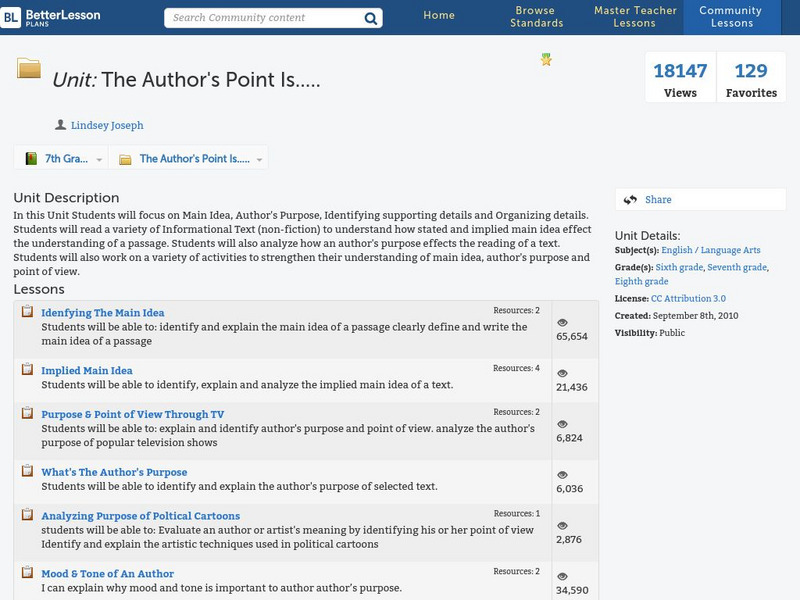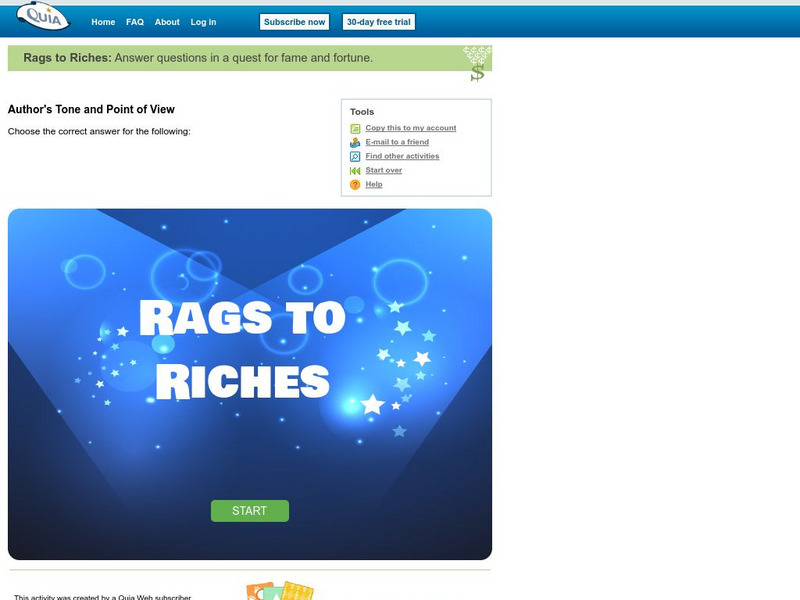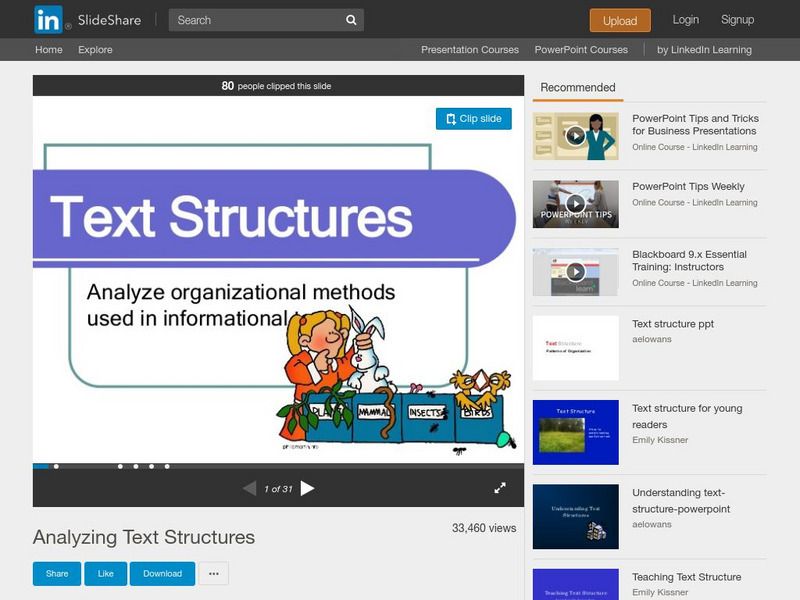Better Lesson
Better Lesson: Unit: The Author's Point Is
Students will focus on Main Idea, Author's Purpose, Identifying supporting details and Organizing details. Students will read a variety of Informational Text (non-fiction) to understand how stated and implied main idea effect the...
Khan Academy
Khan Academy: Primary Purpose Quick Guide
Primary purpose questions ask us to identify why the author may have written the passage. As you read through the passage the first time, it's a good idea to always be asking yourself: "So what?" "What's the point?"
Khan Academy
Khan Academy: Purpose of Reference Quick Guide
Purpose of reference questions ask you to identify why the author referred to something in a certain part of the text. In other words, what was the point of including the reference?
Quia
Quia: Rags to Riches Author's Tone and Point of View
Answer questions about author's purpose, tone, and point of view in this Rags to Riches style game.
Texas Education Agency
Texas Gateway: Explain the Controlling Idea, Purpose, and Distinguish Details
[Accessible by TX Educators. Free Registration/Login Required] In this lesson, students will learn how to pinpoint the controlling idea, which not only identifies the main idea, but also answers questions about the author's goal or...
Better Lesson
Better Lesson: Work Out Together
Students will read an article and determine the author's point and identify the reasons the author gives to support his or her point. This lesson requires analysis by the students and a great deal of higher-order thinking as they...
British Library
British Library: 19th Century Non Fiction Texts: Crime & Punishment
This thematic collection will allow students to read and understand 19th-century non-fiction texts, and support them in identifying key features for a range of genres, audiences, and purposes. Each source is accompanied by original...
British Library
British Library: 19th Century Non Fiction Texts: Work & Welfare
This thematic collection will allow students to read and understand 19th-century non-fiction texts, and support them in identifying key features for a range of genres, audiences, and purposes. Each source is accompanied by original...
British Library
British Library: 19th Century Non Fiction Texts: Gender, Behaviour & Etiquette
This thematic collection will allow learners to read and understand 19th-century non-fiction texts, and support them in identifying key features for a range of genres, audiences, and purposes. Each source is accompanied by original...
British Library
British Library: 19th Century Non Fiction Texts: Education
This thematic collection will allow students to read and understand 19th-century non-fiction texts, and support them in identifying key features for a range of genres, audiences, and purposes. Each source is accompanied by original...
Read Works
Readworks: Reading Lesson 3: To Persuade
This instructional activity focuses on identifying text evidence that shows that the author's purpose is to persuade. Draw a conclusion about what the author is trying to persuade the reader to do or think. Text, worksheet, and chart are...
ReadWriteThink
Read Write Think: Nonfiction Pyramid
A printable pyramid for use with nonfiction texts while students identify the main ideas and supporting details within a text. Students also determine author's purpose and key vocabulary words. Directions on how to use this type of...
Tom Richey
Slide Share: Text Structures: Analyze Organizational Methods
This slideshow focuses on text structures for informational texts including how the author's purpose helps determine the organizational pattern to use and how the reader can use clues to identify the text structure used. Five...
E Reading Worksheets
E Reading Worksheets: Tone Worksheets and Lessons
This learning module provides remediation and extra practice with identifying an author's tone. Reinforcement for understanding author's tone is provided through the five different worksheets and a mini-lesson. CCSS.ELA-Literacy.CCRA.R.4
E Reading Worksheets
E Reading Worksheets: Genre Worksheets
This learning module provides remediation with identifying genre of books and various texts. Practice with capitalizing nouns is provided with through worksheets, an online site, and a video tutorial. .
ClassFlow
Class Flow: Rhetorical Devices and Historically Significant Speeches
[Free Registration/Login Required] This flipchart gives students the opportunity to analyze Abraham Lincoln's Gettysburg Address and Martin Luther King, Jr.'s I Have a Dream speech and identify the rhetorical devices that make them...
E Reading Worksheets
E Reading Worksheets: Theme Worksheets
This learning module provides remediation and extra practice with identifying themes in short stories and in fables. Nine different worksheets and a PowerPoint lesson are available to help reinforce the concept of theme.
Scholastic
Scholastic: Informational Text: Reading Response: Main Ideas & Details [Pdf]
This graphic organizer can be used with students when they read informational text. Students will write the main idea in a central oval and then write four details that support the main idea of this reproducible graphic organizer.
Fun Trivia
Fun Trivia: The Four Types of Writing Trivia Quiz
A fifteen-question quiz in which the reader identifies a type of writing for each situation: argumentation, exposition, narrative, or description. Correct answers are displayed once answers are submitted.
Sophia Learning
Sophia: Rhetorical Analysis of "So This Was Adolescence"
This PDF lesson plan prepares students for multiple portions of the AP Language and Composition exam (specifically, the multiple choice section and the rhetorical analysis prompt) by analyzing a brief text which students will be able to...
Big Learners
Biglearners.com: ccss.ela literacy.ri.1.8 : First Grade English Language Arts
Here is a collection of our common core aligned worksheets for core standard RI.1.8. A brief description of the worksheets is on each of the worksheet widgets. Click on the images to view, download, or print them. All worksheets are free...
Curated OER
Mc Graw Hill: Analyze Language Choices
Learn about figurative language and how to determine the figurative, denotative, and connotative meanings of words.












![Scholastic: Informational Text: Reading Response: Main Ideas & Details [Pdf] Graphic Scholastic: Informational Text: Reading Response: Main Ideas & Details [Pdf] Graphic](https://content.lessonplanet.com/knovation/original/241272-21ebac911f8734b3826318f202df38b5.jpg?1661510811)

